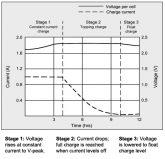Not exactly sure, what it is about? But each LA cell needs somewhere around 2.35 Volts to be fully charged (14.1V for 6 cells).
Alternators must put a slightly higher voltage, continuously to be able to do that.
[illustration deleted]
What could be behind that?

Why should there be a high enough voltage differential for SCC to open charging FETs?
They should be regulated by present battery voltage and not the PV input (barring over voltage situation).
Going by that @14.5V on the Inputs side, an SCC should be able to charge LifePo4 batteries sufficiently (13.4V).
However, never tested that arrangement. Do you have any experience with this?



